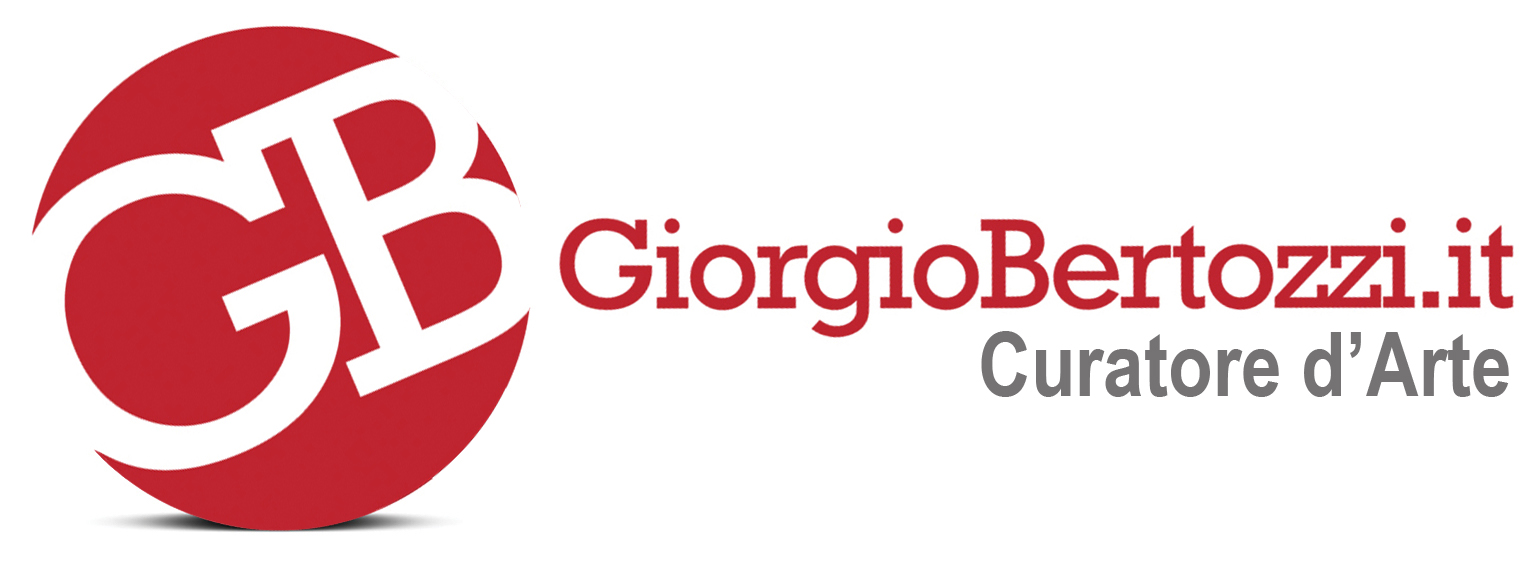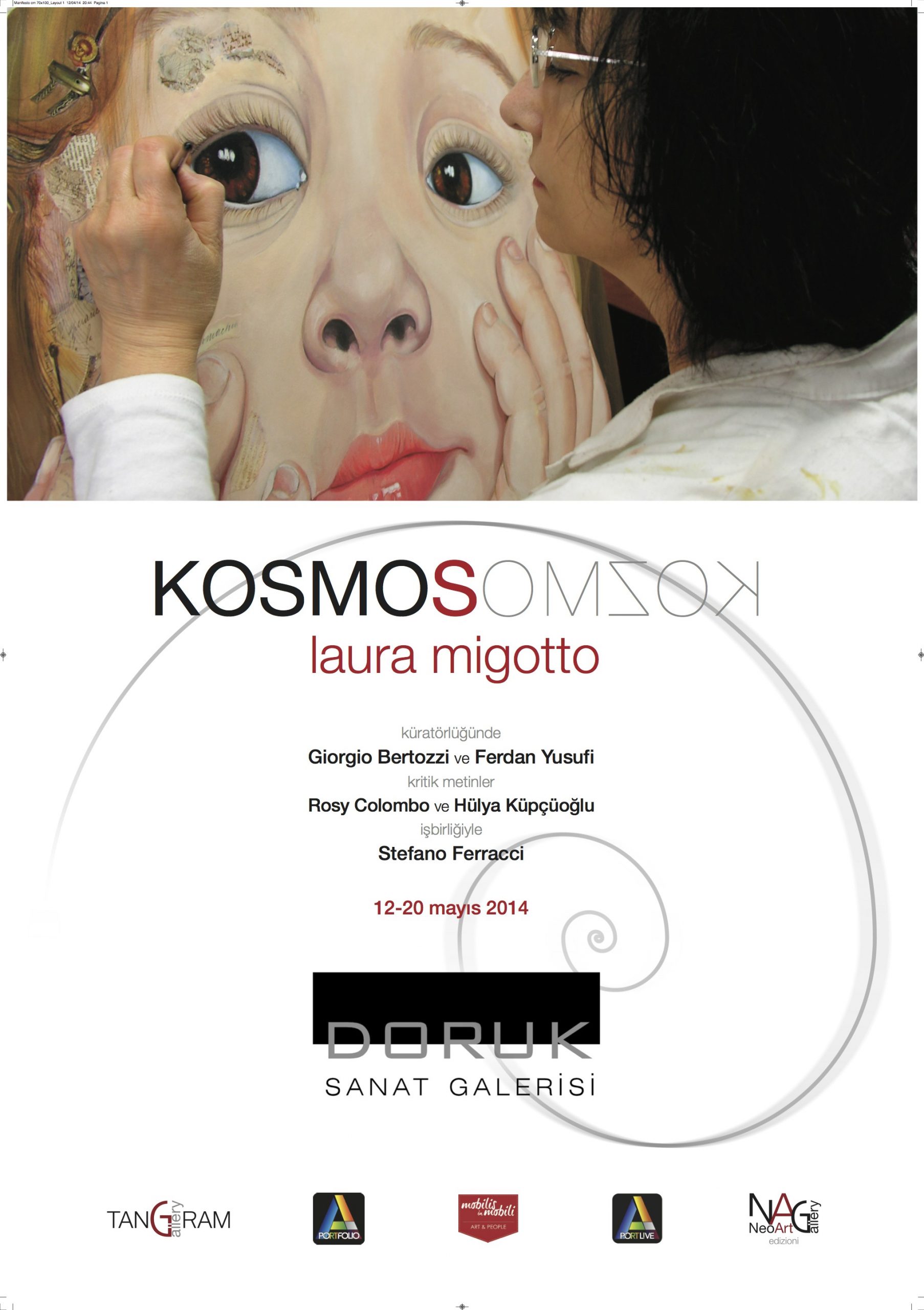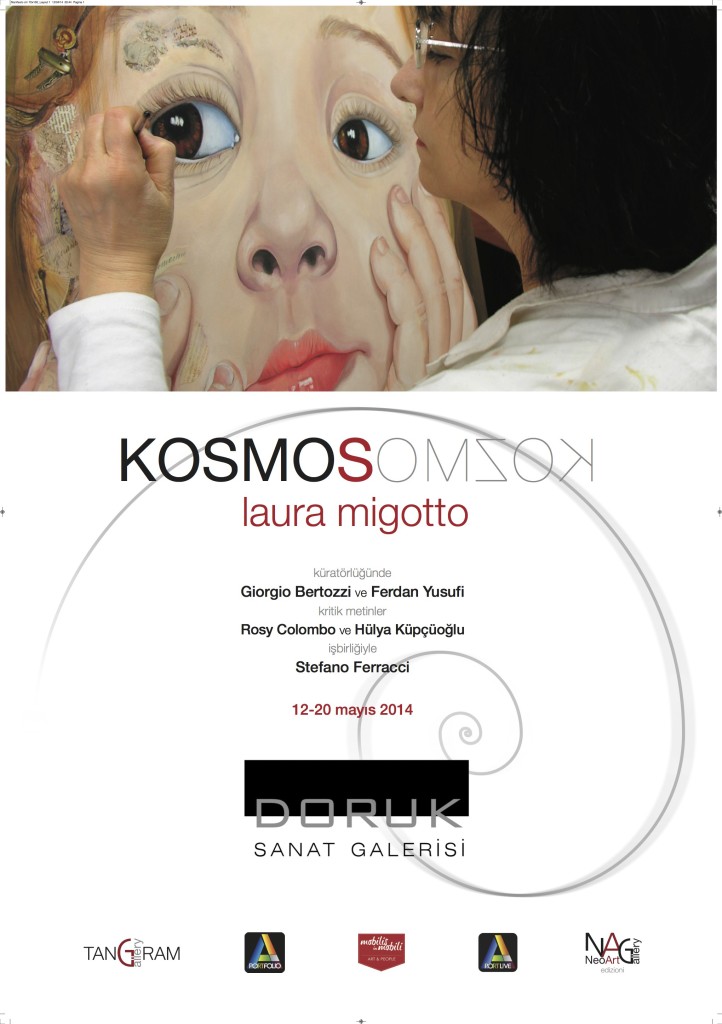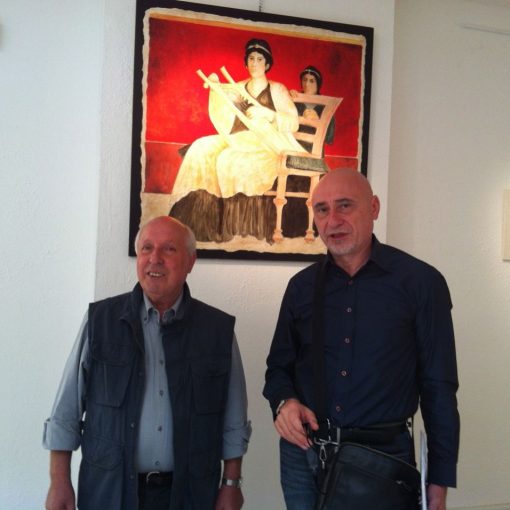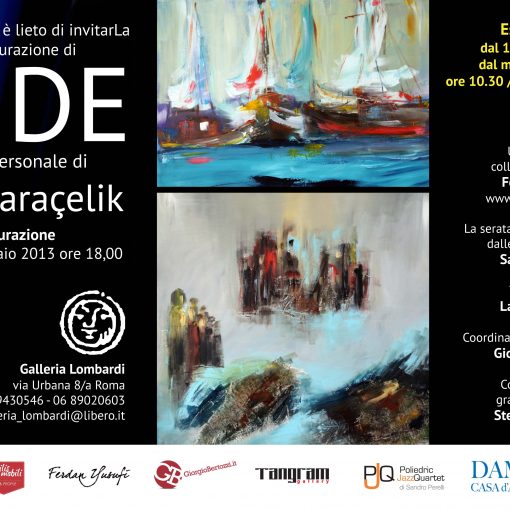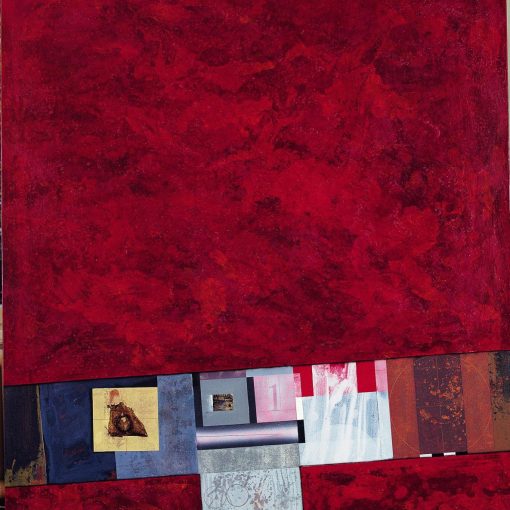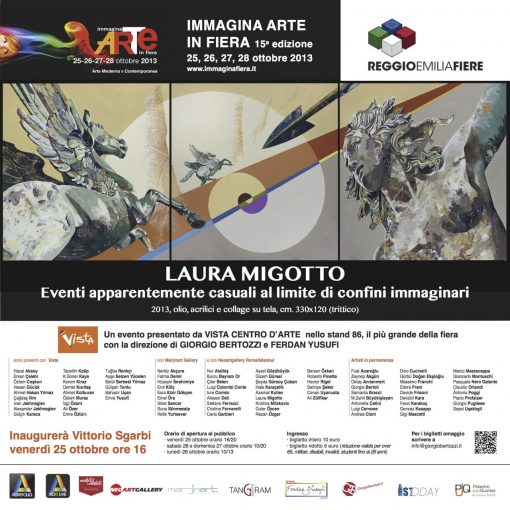KOSMOS
opere di
LAURA MIGOTTO
a cura di · küratörlüğünde
Giorgio Bertozzi ve Ferdan Yusufi
testi critici · kritik metinler
Rosy Colombo ve Hülya Küpçüoğlu
coordinamento grafico-editoriale · işbirliğiyle
Stefano Ferracci
cocktail lunedì 12 maggio 2014 ore 18
açılış kokteyli 12 mayıs 2014 saat 18
esposizione dal 12 al 20 maggio
12-20 mayıs 2014
Doruk Sanat Galerisi
Boğazkesen cad. no:21/A Tophane/İstanbul
Tel: +90 212 252 05 35
doruksanatgalerisi@gmail.com – www.doruksanatgalerisi.com
Si inaugura lunedì 12 maggio alle ore 18, negli spazi della Galleria Doruk di Istanbul, la mostra di Laura Migotto dal titolo Kosmos, curata da Giorgio Bertozzi e Ferdan Yusufi, con testi critici di Rosy Colombo e Hülya Küpçüoğlu.
Giorgio Bertozzi ve Ferdan Yusufi’nin küratörlüğünü yaptığı, Rosy Colombo ve Hülya Küpçüoğlunun sanat metinlerini yazdığı, Laura Migotto ‘Kosmos’ adlı Sergi 12 mayıs saat 18.00 de İstanbul Doruk Sanat Galerisinde izleyiciyle buluşacaktır.
Per questa mostra personale Laura Migotto propone i lavori della sua recente produzione che delineano appieno i tratti fondamentali della sua ricerca artistica, scandita dalla grande passione per l’arte classica e figurativa e il simbolismo che evoca il trascorrere del tempo, tema assai caro all’artista.
La spirale, simbolo stesso della vita, diventa così la cifra stilistica distintiva dell’artista, dando vita a un linguaggio in cui contemporaneo e classicismo si fondono insieme e trovano armonia ed equilibrio tra l’arte classica del passato e il vorticoso scorrere del tempo.
LAURA MIGOTTO: LA MANO DEL TINTORE
Kosmos è la sintesi della ricerca espressiva di Laura Migotto e insieme l’apertura verso una fase innovativa della sua creatività. Convergono nella mostra, fra gli altri, due elementi inconfondibili del suo talento nell’orizzonte dell’arte visiva contemporanea: per un verso la tavola o tela, non a caso spesso di grandi dimensioni, usata dall’artista come una sorta di palcoscenico per la messa in scena del lavoro dell’immaginazione, sia a livello di tecnica compositiva, sia sul piano della visione; per altro verso un’idea di bellezza carica di pensiero, peraltro suggerita dal titolo stesso della mostra. Emblematica in tal senso è la composizione a olio che tematizza l’atto del pensare nella testa di una bellissima figura infantile, legata a un mondo immaginario dell’infanzia, che però non è quello dell’infanzia contemporanea abitata dagli oggetti del consumo corrente; come indica il titolo – “Ricordi dimenticati ai margini di un infinito esistente”- esso è piuttosto legato alla memoria di vecchi giocattoli, chiamando così in causa il tema del tempo – un tema caro all’artista, spesso ricorrente nelle sue opere.
Certo, le doti di Laura Migotto non sono quelle di un pensatore concettuale; il suo talento è piuttosto incarnato in una pratica che sa usare i colori in senso metaforico, applicati a immagini simboliche e a figure mitologiche che eccitano la sua immaginazione. L’interesse per i simboli e per l’organizzazione multistrutturale della composizione è sempre stato un nodo importante della sua estetica, dominata, fin dall’inizio, da esperimenti nell’astrazione, anche se mai in modo statico. Esemplare è la comparsa dell’elemento figurativo d’impronta realistica e comunque referenziale; una svolta rispetto al rigore dell’astrazione geometrica dominante nei suoi lavori precedenti. Astrattismo mai puro, però, ma calato in un paesaggio della memoria, ispirato a statue, o a maschere di tradizione mitologica: cavalli alati e altre figure archetipiche della classicità trasformate dal lavoro del tempo e dalla mano dell’artista contemporaneo in frammenti e in ibridi incroci. Figure comunque mai intere, nelle quali prevalgono le tinte del grigio, del nero, e i toni del chiaroscuro; mentre all’elemento astratto, mai abbandonato anche se in forme incompiute, è assegnata una forte vivacità cromatica, persino accecante.
La cifra identitaria di Laura Migotto è la spirale, perseguita con una serialità che appartiene alla grafica nella quale l’artista si è formata e che è forse alla base di un’estetica del segno nella quale quella figura sempre ritorna come simbolo generativo della creazione artistica, ricordando la grande conchiglia assunta a suo tempo (1978) da Giorgio Strehler a simbolo di una sua memorabile regia della Tempesta di William Shakespeare al Piccolo Teatro di Milano. Figura dell’infinito al quale aspira l’immaginazione dell’artista, ma anche figura dell’opera d’arte di per sé, che nel suo movimento si ricostruisce, secondo la formula tipica del postmoderno, sempre nuova e sempre uguale. “Sebbene cambiata rinasco identica”, recita il titolo di una composizione, a sua volta ri-iscritto sul capo riccioluto di un frammento di statua, collocato dentro il quadro in posizione simmetrica e opposta rispetto a una sezione dove il linguaggio è decisamente astratto. Tuttavia Migotto lavora la spirale anche come figura che nel suo movimento di espansione e di autoricostruzione attira nel vortice oggetti diversi (si veda “Oggetti in costante mutamento”): tronchi fossili, una figura equina, un mezzo busto di bronzo sul quale la mano del tintore, secondo la definizione che dell’artista ha dato W.H.Auden di Shakespeare – inventore che di fatto è manipolatore di materiali esistenti – ha sovrapposto la vernice di colori brillanti e un collage di frammenti di esistenze altre. Ne risulta una sintesi felice della pratica multiforme di Migotto nelle arti visive: grafica, pittura, scultura, anche con suggestivo richiamo alla fascinazione del ritrovamento dei bronzi di Riace, sui quali una sottomarina natura organica si è inscritta , come una scrittura incisa nel metallo.
In altre composizioni le figure del mondo classico sono lavorate in quanto frammenti che mostrano l’azione del tempo, prestandosi all’incisione di diversi segni, anche verbali, e alla sovrapposizione di tracce ancestrali: ombre, macchie, tracce di mondi in origine separati e indipendenti – antico e moderno, naturale e artificiale – che il movimento della spirale fa interagire, rendendoli necessari l’uno all’altro (“Lontano dove i ritorni esistono”). Si configura così la costruzione di un cosmo al centro del quale una spirale mette in contatto profondo, come la grande conchiglia della Tempesta shakespeariana, linguaggio geometrico, linguaggio scenico figurativo, linguaggio del colore.
Accade tuttavia che in più composizioni la spirale venga trafitta da un segno rigido, di natura cuneiforme; un segno forte, che in un caso inquietante, come in “Torre di guardia su un tempo in duplice espansione”, è direttamente assimilato alla lama di una spada, rivelando che l’aspirazione al senso e alla perfezione, espressi dalla potenza della spirale di espandersi all’infinito può, deve anzi, venire interrotta. Al nucleo originario dell’armonia è necessaria l’intromissione di un corpo estraneo, agente di una ferita che incide sulla visione del Kosmos immaginato dall’artista; e che Laura Migotto ci consegna come chiave di lettura non soltanto della sua opera, ma anche del nostro tempo.
Rosy Colombo – Sapienza Università di Roma
LAURA MIGOTTO: THE DYER’S HAND
Kosmos is both a synthesis of Laura Migotto’s experimentation and the beginning of a new and innovative creative period. Along with many others, there are two converging aspects of her talent in the exhibition and that have made her work so unmistakeable in the contemporary visual arts. First, there is the canvas or board, which, significantly, is often large, used by the artist as a sort of stage for the mise-en-scène of the work of her imagination, at the level both of compositional technique and of vision. And then there is an idea of beauty charged with thought, as is also suggested by the title of the exhibition. In this sense there is an emblematic work in oils whose theme is the act of thinking in the head of a beautiful figure of a child, linked to an imaginary world of childhood that is not that of contemporary childhood, dominated by objects of current consumption; as is indicated by the title – “Memories forgotten on the fringes of an existing infinity”- it is linked rather to the memory of old toys, which brings in the theme of time – one that is dear to the artist and which often recurs in her works.
Of course, Laura Migotto’s talents are not those of a conceptual thinker; her gift lies, rather, in her capacity to use colours metaphorically, applying them to symbolic images and mythological figures that excite her imagination. The interest in symbols and a multi-structural organization of the composition has always been an important part of her aesthetic, which was dominated from the start by abstract experimentation, which was never static. There is, for example, the appearance of a realistic, or at any rate referential, figurative element – a new direction after the rigour of the geometrical abstraction that dominated her previous works. The abstractionism is never pure, however, but set in a landscape of the memory, inspired by statues or masks from mythological tradition: winged horses and other archetypal figures of classicism transformed by time’s work and the contemporary artist’s hand into fragments and hybrid cross-fertilizations. But the figures are never whole, and in them grey, black and chiaroscuro tones predominate; while the abstract element is never abandoned, though it is there in incomplete forms, and given a strong and even blinding chromatic vividness.
The identifying figure in Laura Migotto’s art is the spiral, whose serial recurrence in her work reminds us of the graphic art in which she was trained. It may be at the basis of an aesthetic of the sign in which it always returns as a generative symbol of artistic creation, recalling the great shell that Giorgio Strehler used as a symbol in his memorable 1978 production of The Tempest at Milan’s Piccolo Teatro. It is a metaphor of the infinite to which the artist’s imagination aspires, but also a metaphor for the work of art in itself, whose movement, in the typical post-modern formula, reconstructs itself always new and always the same. “Though changed I am reborn identical” is the title of a composition that is alsore-written on the curly head of a fragment of statue, placed inside the painting symmetrically opposite a section whose language is decidedly abstract. Yet Migotto also works on the spiral as a metaphor whose expanding and self-reconstructing attracts different objects into its vortex (see “Objects in constant change”): fossil trunks, the figure of a horse, a bronze bust on which her dyer’s hand, to use the definition of the artist that W.H. Auden gave of Shakespeare – an inventor who is actually manipulating existing materials – has overlaid brilliantly coloured paint and a collage of fragments of other objects. The result is an effective synthesis of Migotto’s varied practice in the visual arts: graphics, painting and sculpture, as well as a striking suggestion of the fascination of the discovery of the bronzes of Riace, on which the underwater marine life had inscribed itself, like writing engraved in metal. In other compositions the forms of the classical world have been worked as fragments showing the action of time, lending themselves to the engraving of verbal and other signs, and the superimposition of ancestral traces: shadows, stains, traces of worlds that were once separate and independent – ancient and modern, natural and artificial – that are made to interact with each other by the movement of the spiral, each one becoming necessary to the other (“Far away where returns exist”). Out of this emerges a cosmos, at the centre of which, a spiral, like the great shell in Shakespeare’s Tempest, that inextricably combines a geometrical language, a figurative scenic language, and the language of colour.
But it sometimes happens that in a number of compositions the spiral is pierced by a rigid, wedge-shaped sign; a strong sign that, in one disquieting case, is directly assimilated to the blade of a sword (“Watchtower over a time doubly expanding”). It is as if to reveal that the aspiration to sense and perfection, expressed by the power of the spiral to infinitely expand, can, or must, be interrupted. The original nucleus of harmony requires the intrusion of an alien body, the agent of a wound that leaves its mark on the vision of the Kosmos imagined by the artist; and which Laura Migotto gives us as a means of interpreting not only her work, but our time as well.
Rosy Colombo – Sapienza University, Rome
LAURA MIGOTTO
L’opera di Laura Migotto è caratterizzata dalla presenza costante di figure appartenenti all’arte classica, reinterpretate con un linguaggio contemporaneo. Forte è l’effetto “volume” delle figure in primo piano, sculture classiche e cavalli alati che prendono vita e che, con i loro volumi forti e ben definiti, si contrappongono alle superfici piatte e bidimensionali degli sfondi trattati con colori puliti e decisi dove è pressochè costante la presenza della spirale presa come simbolo che rimanda ai temi dell’universo, della natura, del DNA ma soprattutto del tempo che trascorre.
Hülya Küpçüoğlu
LAURA MIGOTTO
Laura Migotto, mitolojik figürleri çağdaş bir dil ile yorumlayarak günümüze taşıyor. Mekan iki boyutlu yüzeylerden, figür ise hacimli ve üç boyut etkisi oldukça kuvvetli bir etki ile oluşturuluyor. Eserlerinde Postmodern gönderimleri olan sanatçı, sarmal formu sıklıkla yineleyerek, formun, insan DNA’sından yaşadığımız dünyadaki bazı hayvanlara ve evrene kadar pek çok yapıya gönderim yapıyor. Migotto’nun heykelleri de tıpkı resimlerindeki gibi sarmal formun yinelenmesi ve özellikle at figürünün ön plana çıkarılması ile hayat buluyor.
Hülya Küpçüoğlu
